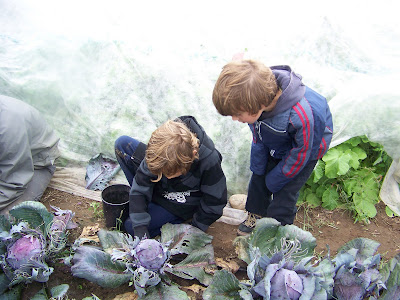It's garlic-planting time. Actually, it's getting on the late side to plant garlic already...but it's been awfully wet the past couple of weeks so we're a bit behind schedule. This year we're excited to trial a few types of heirloom garlic from Seeds of Diversity's Great Canadian Garlic Collection. Not sure yet which varieties we're going to get, but they're bound to be an interesting diversion from the standard 'Music' grown almost solely by most Canadian garlic producers.
You may have noticed that Ontario garlic is particularly expensive this year. The wet/drought combination were hard on the crop, and nematode damage was pervasive. (As point of reference, this fall organic seed garlic is priced at $9/lb!! Steep!) It's the nematode damage that's most concerning though - these little microscopic worm-like parasites overwinter on affected cloves & start back in with their eating come spring. We only experienced some mild nematode damage this year, but the problem can compound from year to year & become quite devasting.
There's a tricky heat treatment that's supposed to help, recommended by the Garlic Grower's Association of Ontario... but it involves treating the bulbs in a hot water bath at exactly 120F for 20 minutes - something I'm pretty skeptical of my ability to accomplish with a mere pot & stove element. The window between killing the nematode and killing the garlic cloves is awfully narrow!! Which is the worse risk...losing my 2012 crop to nematode damage, or losing it to death by cooking? Need to answer this internal debate soon or it'll be too late to plant.
In better news, other than nematode treatment, the garlic is cracked & ready to put in the ground, thanks to the help of our awesome members who tackled breaking apart most of 70lb of cloves at CSA pick-ups a couple of weeks ago!
Wednesday, October 26, 2011
Wednesday, October 5, 2011
Challenge & Gratitude
So far, every season has been quite different from the ones before: weather, staffing, CSA size and the particular challenges of growing have changed from year to year. It’s been quite the learning curve. This past year started with the familiar (but particularly extreme) cool/wet challenge, but then hit us hard with hot drought. I feel like all we did in July was harvest and wrestle with drip tape. We also struggled with operating short-handed for much of June & July after Sarah left her internship, and until Carrie came aboard to help us out.
Cool, wet weather tends to contribute to disease issues; whereas hot, dry conditions favour pests. This year was definitely the year of the worm. We had tomato hornworms, cabbage loopers and woolly bear caterpillars in quantities I’ve never seen before. The flea beetle was particularly aggressive as well. All the critters got under the row cover and in some cases (broccoli) ate so much greenery there were only leaf spines left! Distressing, to say the least. But not as distressing as our biggest problem this season: a chronic boron deficiency which has been liquefying many of our cabbage crops, reducing them to putrid goo. I’m still worried about the quality & quantity of our fall vegetables. The late season kale, cabbage, turnips, rutabaga, broccoli, cauliflower, radishes, kohlrabi and asian greens have all been significantly affected by worm and boron damage.
(An example of the boron damage goo-ifying the core of a turnip root.)
So yes. Challenges aplenty. But it makes me reflect again on how fortunate I am to be growing in the context of supportive community. We couldn’t have survived this season otherwise. We had an incredible squadron of committed volunteers show up to help through the really intense months of June & July, CSA members who stoically (even jovially!) spent hours removing rotting cabbages & squishing looper worms at our September work bee. People have dropped off meals on my doorstep and sent encouraging notes. And you – along with the fantastic market & Bailey’s customers – have continued to feed ME by providing our best year of sales yet.
Together, we’re doing something pretty incredible here. We’re creating a food system buffered from the vagaries of the world market. I ache for my neighbouring farmers whose stunted corn will have low yields, sold too cheaply at world commodity prices; whose poor hay crops will likely lead to smaller livestock sold too cheaply at the stockyards; and who will likely have to work more hours off-farm to inject income back into their farms this winter.
We are, instead, contributing to a healthy local food system. We’re building true food security by buffering risk and sharing labour over a broader base. You’re supporting me with a reasonable wage so I can continue to grow your food into the future. We’re building our community’s food-growing skills. We’re strengthening our resilience. A year like this one could have been a disaster, but instead it’s been our most profitable. I am encouraged and deeply grateful.
(From the October CSA newsletter)
Volunteers from our Labour Day Work Bee - squishing cabbage loopers & culling the rotty cabbage heads...
... picking beans...
(From the October CSA newsletter)
Volunteers from our Labour Day Work Bee - squishing cabbage loopers & culling the rotty cabbage heads...
... picking beans...
..trimming garlic...
...and rolling up the used drip tape.
A huge thank-you to all who have supported Fertile Ground by volunteering, purchasing shares, buying from us at market or Bailey's, sharing my excitement, or offering words of support, encouragement or advice.
Subscribe to:
Comments (Atom)
.gif)














